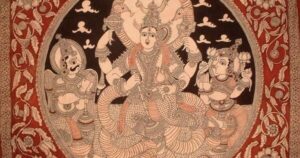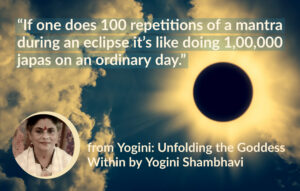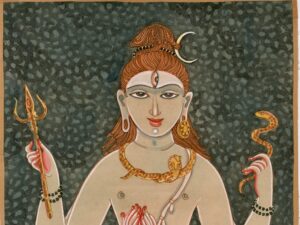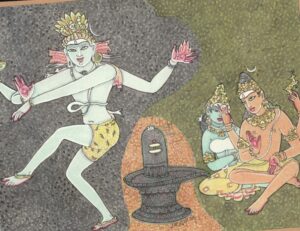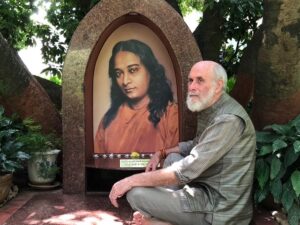According to the philosophy of Yoga, the physical body is a manifestation of consciousness. It is a crystallization of karmic (behavioral) patterns created by the mind. The key to working with the body, therefore, is to understand the consciousness behind it, much of which lies outside our ordinary awareness. This requires that we practice asanas aware not only of the technicalities of the postures but also of the mental and emotional states that they create within us.
Ayurveda shares this Yoga theory. It views the body as a manifestation of the doshas, which are not merely physical but also pranic and psychological energies-factors of consciousness. We cannot look into the doshic impact of asanas purely on a physical level but must consider their psychological effects as well.
Yoga views asanas not merely as static poses but as conditions of energy, which in turn are manifestations of consciousness. The energy and attention that we put into the pose is as important as the pose itself. We can see this in ordinary life in which how we feel on a psychological level determines how we move on a physical level. Long term patterns of feeling and energy determine the form and rhythm of the body.
Asana as Physical Structure
At the most basic level, an asana is a physical pose, a kind of bodily gesture. In asana practice we place the body into a position that has a specific result and message depending upon the shape that it creates with the body. Each asana has its own structural effect. Sitting poses provide stability in the spine. Some of them create flexibility in the backs of the legs. Since most sitting postures create parasympathetic stimulation, they create a pleasant calming influence. Standing poses increase general strength and energy levels. Backbends tend to excite us (sympathetic stimulation), increase spinal extension, and create strength in the trunk elevator muscles. Relaxation poses even out and calm the energies created by our asana practice. All asanas, whether in groups or individually, have their own energetics depending upon what they do to the body. Like a house they have their own architecture.
However, since all our bodies do not have the same structure, the experience of an asana will vary depending upon the build, flexibility and organic condition of the individual. The effect of the asana is a combination of the structure of the asana, which is the same for everyone, and the person’s own bodily structure, which will vary not only by individual but also changes through the course of time.
Asana as Pranic Energy
The physical body is a vehicle for our internal energies, which are defined through Prana. Asanas are vehicles through which Prana is directed. An asana is not merely a physical structure but a condition of energy. Asanas express a quality of energy and even quieting poses can contain behind them a dynamic condition of mind and Prana. This fact gives all asanas a certain neutrality in their energetic effects, just as a vehicle in itself is neutral, with the goal of its travel depending on the driver. The asana is like a car with Prana as the driving force. It is not just a question of having the right vehicle but also of moving it in the right way. The pranic impulse behind the asana is as important as the asana itself.
This means that depending upon how we direct our Prana, the same asana can take us to different places. For example, a sitting posture done with strong pranayama can have a very energizing effect, while with ordinary breathing it will quiet us or even put us to sleep. The pranic energetics of an asana depend upon various factors including on how quickly we do the posture, the degree of force we use and, above all, on how we breathe during the asana. In fact, the goal of asana practice is to calm the body so that we can work on our Prana. Prana manifests when the body is still. This is the importance of sitting poses for internal healing.
Asana as Thought and Intention
Asana is not only structure and energy but also reflects thought and intention. We could call asana a ‘thoughtful’ or ‘mindful’ form of exercise. The effects of the same asana will vary depending upon whether our mind is clear or cloudy and our emotions are calm or turbulent. We may perform an asana with technical precision but our state of mind will determine how liberating the asana actually is for our consciousness.
Our mental state is reflected in our breath. When the mind is calm, the breath is calm. When the mind is disturbed, the breath is disturbed. So, mental and pranic energetics go together. While we can change the pranic effect of an asana through the breath, we can also change the mental effects of an asana through concentration and meditation. An asana should be a kind of meditation in form or movement. Therefore, we should always put our minds into a sacred space of silence, observation, and detachment while performing Yoga.
If our consciousness is not engaged during the asana, then our practice remains at a superficial level. Prana follows the energy of attention. The bodily posture is an outcome of that. The kind of posture that a person has reflects how they place their attention in life, what they most commonly do. That is why so many of us are hunched over today. Our main posture is sitting at a desk, in a car, or on a couch! This places our energy outside ourselves and so our internal energy sinks or collapses.
Ayurvedic Effects of Asanas
Each asana has a particular effect defined relative to the three doshas. This is the same as how Ayurveda classifies foods according to their doshic effects as good or bad for Vata, Pitta and Kapha, depending upon the tastes and the elements that compose each food article. We can look upon different asanas according to their structural ability to increase or decrease the doshas.
However, this doshic equation of asanas should not be taken rigidly because the pranic effect of an asana can outweigh its structural affect as we just noted. The form of the asana is not its main factor. Through the use of the breath we can modify or even change the doshic effects of the asana. We must remember the importance of thought and intention in asana practice as well. Considering the asana, Prana and the mind, we can alter a particular asana or adjust the entire practice toward a particular doshic result. Through combining specific asanas, pranayama and meditation a complete internal balance can be created and sustained.
Doshic application of asanas is twofold.
-
- According to the constitution of the individual defined by their doshic type as Vata, Pitta and Kapha and their intermixtures.
- Relative to the impact of asana on the doshas as general physiological functions. Each dosha has its sites and actions in the body that asanas will effect depending upon their orientation.
AYURVEDIC BODY TYPES AND ASANA PRACTICE
To understand the asana potentials of different people we look at them according to their doshic body types.
Vata Body Type
Vata types have thin and long bones that are often weak or brittle. They have low body weight and poor development of the muscles, but a good deal of speed and flexibility. Their bone structure makes them good at bending and stretching, particularly of the arms and legs, when they are young. As they get older, however, the dry quality of Vata increases and causes them to lose mobility if they don’t exercise regularly.
A gentle, slow asana practice evenly balanced on both sides of the body is the ideal exercise for Vata types. Vatas are most in need of asana practice because asana alleviates accumulated Vata from the back and the bones, where it easily gets lodged. Vata diseases begin with an accumulation of the downward moving air (Apana Vayu) in the colon, which gets transferred to the bones, where it causes bone and joint problems. Vata benefits from the massaging action of asana on the muscles and joints, which releases nervous tension and balances out the system.
There are two basic conditions of Vata, what are called blocked Vata or deficient Vata. Blocked Vata exhibits a stuck energy somewhere in the body, along with pain or discomfort but otherwise normal body weight. Deficient Vata exhibits low energy, low body weight and hypersensitivity, often without any acute pain. Blocked Vata requires movement oriented or pranic asanas to release it. Deficient Vata requires a gentle and building approach, avoiding strong exertion. Blocked Vata is more common in young people who have adequate energy but get it blocked, while deficient Vata is more common in the elderly whose tissue quality is in decline.
| Negative Potential of Vata |
| Vata types more commonly suffer from stiffness owing to dryness and deficiency in the tissues. Their lack of body weight does not allow for adequate cushioning of the joints and nerves or proper hydration of the tissues. They are more prone to injury because they like to initiate sudden and abrupt movements, as well as going to extremes in their practice. |
| Positive Potential of Vata |
| Vata types like movement and exercise and enjoy movement. They prefer to be active and expressive both physically and mentally and like to do new things. Asana is something that they easily take to and grow accustomed to as part of their active nature. It is a soothing way for them to exercise. |
Pitta Body Type
Pitta types have an average build with a generally good development of the muscles and a looseness of the joints, which gives them a fair amount of flexibility. They are good at asana practice but cannot do some of the more exotic poses that Vatas can do because of the shorter bones that they usually have. Pittas benefit from asana practice to cool down the head, cool the blood, calm the heart and relieve tension. For example, Pittas tend to hypertension because of their fiery temperament that keeps them always wanting to succeed or to win.
| Negative Potential of Pitta |
| Pitta types tend to be overheated and irritable owing to excess internal heat. They may lack the patience to get started in practice or to stick with it over time. On the other hand, once involved they can overdo postures and be aggressive and militant in their practice. A Pitta who has pushed too hard in their practice will feel more irritable or even angry after they finish. Pittas also will tend to stick with poses that they can do well and ignore those that may help them develop further. |
| Positive Potential of Pitta |
| Pittas have the best focus and determination of the doshic types. They easily get into a consistent discipline and determined practice once they have gotten it started and oriented correctly. They are the most orderly and consistent of the types. They just have to discover the right path to place their energies. |
Kapha Body Type
Kaphas are typically short and stocky, gaining weight easily. With their short and thick bones they lack flexibility and cannot do poses that require flexibility like the lotus pose. Yet they are sturdy and strong and have the best endurance of the different types. Kaphas need movement and stimulation to counter their tendency to complacency and inertia. They are good at keeping a practice going for longer periods of time, once they get it going in the first place.
| Negative Potential of Kapha |
| Kaphas tend to be overweight, which limits their movement and makes them sedentary. They often have congestion in the lungs that makes deep breathing difficult. They lack in positive effort and find it hard to change without some sort of external stimulation. They need to be constantly prodded to do more or they will stop short in their efforts. |
| Positive Potential of Kapha |
| Kaphas are steady and consistent in what they do. Once they take something up they do it faithfully over time. They remain emotionally calm and even in their practice regardless of the results. They view life with love and work as a service. |
Keys to Practicing Asana for Your Type
Vata
| General | Keep your energy firm, even and consistent; moderate and sustain your enthusiasm |
| Body | Keep the body calm, centered and relaxed; do the asana slowly, gently and without undue or sudden use of force, avoid abrupt movements |
| Prana | Keep the breath deep, calm and strong, emphasizing inhalation |
| Mind | Keep the mind calm and concentrated, grounded in the present moment |
Pitta
| General | Keep your energy cool, open and receptive, like the newly waxing Moon |
| Body | Keep the body cool and relaxed; do the asanas in a surrendering manner to remove heat and tension |
| Prana | Keep the breath cool, relaxed and diffused; exhale through the mouth to relieve heat as needed |
| Mind | Keep the mind receptive, detached and aware but not sharp or critical |
Kapha
| General | Make sure to warm up properly and then do the asana with effort, speed and determination |
| Body | Keep the body light and moving, warm and dry |
| Prana | Keep the Prana upward moving and circulating; take deep, rapid breaths if necessary to maintain energy |
| Mind | Keep the mind enthusiastic, wakeful and focused like a flame |

